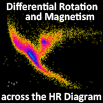Speaker
Lúcia D. V. Duarte
(Max-Planck-Institut für Sonnensystemforschung, Lindau)
Description
Observations of the gas giants show that both planets have
dipolar magnetic fields:
Jupiter's is very similar to the Earth's magnetic field and Saturn's
is very
axisymmetric. In addition, both gas giants present a very
dynamical behaviour of the
atmospheric flow, organized in banded structures of east-west
flow. Our main goal is
to approach more realistic numerical models that explain these
features. While the
small density gradient across terrestrial iron cores allows the use
of the Boussinesq
approximation, the picture is different for the gas giants. Here,
the density
decreases by a factor of around 5000 from the deep interior to
the surface (1 bar
level). Though most of this density jump is accommodated in the
outer molecular
envelopes of the planets, it may still be significant in the metallic
dynamo region.
Among other properties, the electrical conductivity also varies
significantly with
radius, being roughly constant in the metallic hydrogen region
and decaying
superexponentially in the molecular envelope. In this work, we
solve an anelastic
numerical dynamo model (which differs from a fully compressible
model by neglecting
sound waves) to explore the effects of density stratification and
electrical
conductivity variation on the magnetic field generation and on the
configuration and
strength of the surface east-west flow. We use an anelastic
version of the MHD code
MagIC with inner-to-outer boundary density variation of up to
245 and an electrical
conductivity profile that decays exponentially in the outer 5-30%
of the simulated
shell. Previous simulations using constant conductivity showed
that dipole-dominated
magnetic fields are only found for weak density variations. The
exponential
conductivity decrease helps to cancel this effect by separating
magnetic field
generation from the dominant convective region. For intermediate
gradients of the
density stratification (6<density variation<148), the dipole
component clearly
dominates during short periods. Stable and strong dipolar
solutions are found either
when the density variation is larger than 148 at E=10e^(-4),
which results in a more
clear separation between the dynamo and the dominant
convective region, or when the
Ekman number considered is lower than 10e^(-4). Concerning
the flow, we were unable
to reproduce the banded structure of the surface zonal flow, with
the exception of
the strong equatorial jet that is always present. The strength of
the equatorial
surface flow seems to approach planetary values with the
increase of the Rayleigh
number and the density gradient.
Primary authors
Johannes Wicht
(Max-Planck-Institut für Sonnensystemforschung, Lindau)
Lúcia D. V. Duarte
(Max-Planck-Institut für Sonnensystemforschung, Lindau)
Thomas Gastine
(Max-Planck-Institut für Sonnensystemforschung, Lindau)

